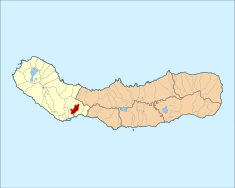Fajã de Baixo
| Fajã de Baixo | |
| Civil Parish | |
| Official name: Freguesia da Fajã de Baixo | |
| Name origin: Portuguese for lower debris field | |
| Country | |
|---|---|
| Autonomous Region | |
| Island | São Miguel |
| Municipality | Ponta Delgada |
| Center | Monte |
| - elevation | 68 m (223 ft) |
| - coordinates | 37°45′44″N 25°38′32″W / 37.76222°N 25.64222°WCoordinates: 37°45′44″N 25°38′32″W / 37.76222°N 25.64222°W |
| Highest point | Charco da Ferreira |
| - elevation | 187 m (614 ft) |
| - coordinates | 37°46′41″N 25°37′51″W / 37.77806°N 25.63083°W |
| Lowest point | Belém |
| - elevation | 37 m (121 ft) |
| - coordinates | 37°45′16″N 25°38′42″W / 37.75444°N 25.64500°W |
| Area | 4.06 km2 (2 sq mi) |
| - urban | 1.4 km2 (1 sq mi) |
| Population | 5,050 (2011) |
| Density | 1,244/km2 (3,222/sq mi) |
| LAU | Junta Freguesia |
| - location | Largo da Igreja |
| President Junta | João Carlos Carreiro |
| Timezone | Azores (UTC-1) |
| - summer (DST) | Azores (UTC0) |
| Postal Zone | 9500-451 |
| Area Code & Prefix | (+351) 292 XXX-XXXX |
| Patron Saint | Nossa Senhora dos Anjos |
|
Location of the civil parish of Fajã de Baixo in the municipality of Ponta Delgada
|
|
| Statistics: Instituto Nacional de Estatística | |
| Geographic detail from CAOP (2010) produced by Instituto Geográfico Português (IGP) | |
Fajã de Baixo is a civil parish in the municipality of Ponta Delgada in the Portuguese archipelago of the Azores. The population in 2011 was 5,050, in an area of 4.06 km². Faja de Baixo is located in the western part of the island of São Miguel, northeast of central Ponta Delgada.
The first Church of Fajã was erected in 1532, to support the small community that began to settle in the region. But, this small church was unable to support the growing congregation and was ordered demolished a few years later.
Sometime in 1699, the Hermitage of Lorêto was completed, and served as a primary temple for the community. The main parochial church, dedicated to Our Lady of Angels (Portuguese: Igreja de Nossa Senhora dos Anjos) was eventually constructed in 1791. Meanwhile, the region was a destination of annual pilgrimages, with stops at the smaller temples at the Hermitage of Senhora da Boa Nova and Hermitage of Santa Rita (erected in 1765).
...
Wikipedia

